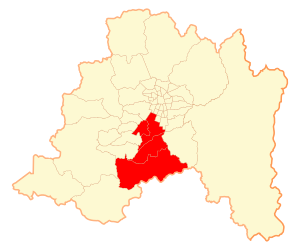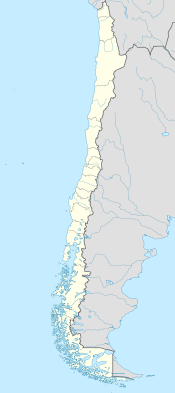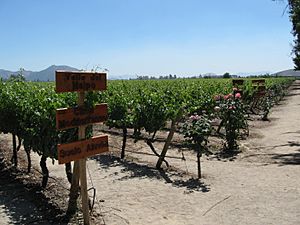Maipo Province facts for kids
Quick facts for kids
Maipo Province
Provincia de Maipo
|
||
|---|---|---|
|
||

Location in the Santiago Metropolitan Region
|
||
| Country | Chile | |
| Region | Santiago Metropolitan | |
| Capital | San Bernardo | |
| Communes |
List of 4:
|
|
| Government | ||
| • Type | Provincial | |
| Area | ||
| • Total | 1,120.5 km2 (432.6 sq mi) | |
| Area rank | 5 | |
| Population
(2012 Census)
|
||
| • Total | 440,591 | |
| • Rank | 3 | |
| • Density | 393.209/km2 (1,018.41/sq mi) | |
| • Urban | 336,198 | |
| • Rural | 42,246 | |
| Sex | ||
| • Men | 187,789. | |
| • Women | 190,655 | |
| Time zone | UTC-4 (CLT) | |
| • Summer (DST) | UTC-3 (CLST) | |
| Area code | 56 + 2 | |
| Website | Delegation of Maipo | |
Maipo Province (which is Provincia de Maipo in Spanish) is one of six provinces in the Santiago Metropolitan Region of central Chile. A province is like a large area or region within a country. Its main city, or capital, is San Bernardo.
Contents
How Maipo Province is Managed
Maipo Province is an important part of Chile's government structure. It is a second-level administrative division, meaning it's a major area within the country. A special person called a provincial delegate runs the province. This delegate is chosen by the President of Chile.
Cities and Towns in Maipo
The province is made up of four smaller areas called communes (or comunas in Spanish). Each commune has its own local government, which includes a mayor (called an alcalde) and a group of people on a municipal council.
- Buin
- Paine
- San Bernardo, which is the capital city
- Calera de Tango
Maipo's Size and People
Maipo Province covers an area of about 1,120.5 square kilometers (432.6 square miles). This makes it the second smallest province in the Santiago Metropolitan Region.
According to a census in 2002, Maipo was the third most populated province in its region. It had a total of 378,444 people living there. Most people, about 336,198, lived in urban areas (cities and towns). The rest, about 42,246 people, lived in rural areas (the countryside). There were slightly more women (190,655) than men (187,789) at that time.
Exploring the Maipo Valley Wine Region
The Maipo Valley is a famous wine region very close to Santiago, the capital city of Chile. It stretches from Santiago east towards the amazing Andes and west towards the coast. It also goes south to towns like Padre Hurtado and Isla de Maipo.
This valley has over 2,955 hectares (about 7,302 acres) of vineyards. More than half of these vineyards grow grapes for Cabernet Sauvignon wine. The Maipo Valley is a historic place for winemaking and is known as the birthplace of the Chilean wine industry. People have been growing grapes here for about 150 years!
The Maipo Valley can be divided into three main parts: Alto Maipo, Central Maipo, and Pacific Maipo.
Alto Maipo: Mountain Influences
The Alto Maipo area is located at the bottom of the Andes Mountains. It ranges from 400 to 800 meters (1,300 to 2,600 feet) above sea level. The mountains greatly affect the weather here. This area is excellent for viticulture (grape growing) because the mountains cause big temperature changes between day and night.
Mornings are cool because the sun takes time to rise over the Andes. Afternoons are warm and sunny. This special climate, along with poor, rocky soil, makes the grapevines work harder. This stress helps produce a strong and elegant Cabernet Sauvignon wine.
Central Maipo: The Heart of Winemaking
The area around the Maipo River is one of the oldest places for winemaking in Chile. It was the first part of the Maipo Valley where people started growing grapes. Cabernet Sauvignon is the main grape grown here. However, the region has also started making wines from Carmenere grapes.
Central Maipo is the warmest and driest of the three sub-regions. It has rocky soils made from river deposits (called alluvial soils). It also gets less rain than Alto Maipo and Pacific Maipo. Because of this, vineyards often use drip irrigation to water the plants. Many vineyards are planted along the Maipo River, where the alluvial soils are perfect for grapes.
Pacific Maipo: Coastal Flavors
Pacific Maipo is the newest wine-producing area in the Maipo Valley. There are not as many vineyards near the Maipo River here. Grapes grown in this region benefit from the cool influence of the Pacific Ocean. They also grow in alluvial soils, similar to Central Maipo.
Red wines from Pacific Maipo have a fresh, natural acidity because of the ocean's influence. The vineyards in this area are often found tucked against smaller hills. These hills protect the vines from strong winds coming off the coast. Because of the ocean's influence, Pacific Maipo is also a popular place to try growing white grape varieties. The most notable white grape grown here is Sauvignon Blanc.
Types of Grapes Grown in Maipo
The Maipo Valley has a Mediterranean climate. It gets about 315 millimeters (12.4 inches) of rain each year. The soils are sandy and gravelly in the east, and more clay-like in the west. The main grape varieties grown here are Cabernet Sauvignon, Carmenere, and Syrah.
Here is a look at how many hectares (a unit of land area) are planted with different grape types:
| Cabernet Sauvignon: 6,433 ha (15897 acres) | Merlot: 1,103 ha (2726 acres) | Carménère: 810 ha (2002 acres) |
| Syrah: 975 ha (2409 acres) | Sauvignon Blanc: 694 ha (1715 acres) | Chardonnay: 1,056 ha (2609 acres) |
| Pinot Noir: 129 ha (319 acres) | Malbec / Cot: 80 ha (198 acres) | Cabernet Franc: 259 ha (640 acres) |
In total, about 12,955 hectares (7,302 acres) of land are planted with grapes in the Maipo Valley.
See also
 In Spanish: Provincia de Maipo para niños
In Spanish: Provincia de Maipo para niños




